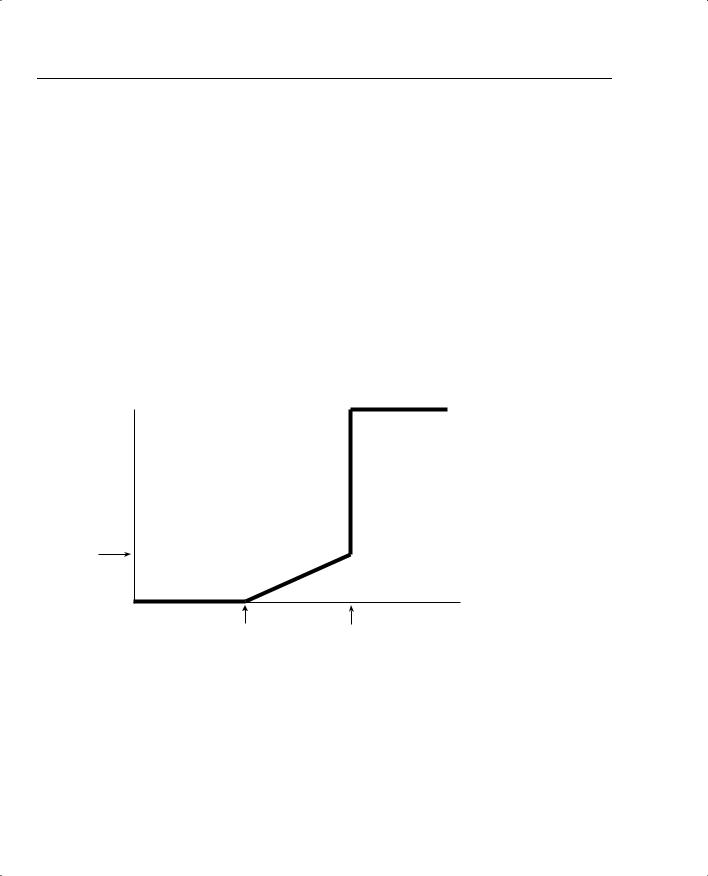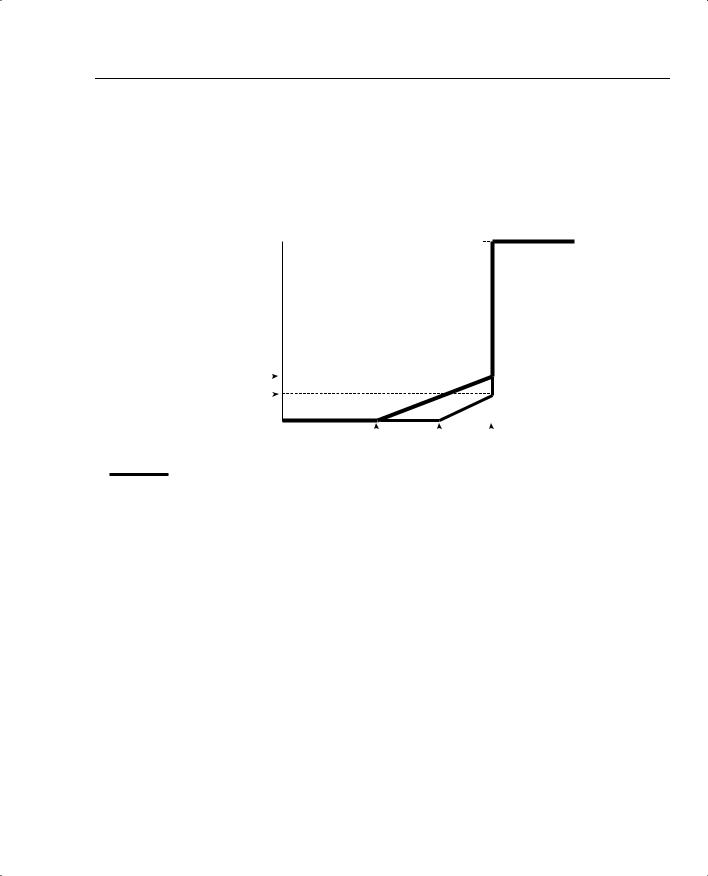
- •QoS Overview
- •“Do I Know This Already?” Quiz
- •QoS: Tuning Bandwidth, Delay, Jitter, and Loss Questions
- •Foundation Topics
- •QoS: Tuning Bandwidth, Delay, Jitter, and Loss
- •Bandwidth
- •The clock rate Command Versus the bandwidth Command
- •QoS Tools That Affect Bandwidth
- •Delay
- •Serialization Delay
- •Propagation Delay
- •Queuing Delay
- •Forwarding Delay
- •Shaping Delay
- •Network Delay
- •Delay Summary
- •QoS Tools That Affect Delay
- •Jitter
- •QoS Tools That Affect Jitter
- •Loss
- •QoS Tools That Affect Loss
- •Summary: QoS Characteristics: Bandwidth, Delay, Jitter, and Loss
- •Voice Basics
- •Voice Bandwidth Considerations
- •Voice Delay Considerations
- •Voice Jitter Considerations
- •Voice Loss Considerations
- •Video Basics
- •Video Bandwidth Considerations
- •Video Delay Considerations
- •Video Jitter Considerations
- •Video Loss Considerations
- •Comparing Voice and Video: Summary
- •IP Data Basics
- •Data Bandwidth Considerations
- •Data Delay Considerations
- •Data Jitter Considerations
- •Data Loss Considerations
- •Comparing Voice, Video, and Data: Summary
- •Foundation Summary
- •QoS Tools and Architectures
- •“Do I Know This Already?” Quiz
- •QoS Tools Questions
- •Differentiated Services Questions
- •Integrated Services Questions
- •Foundation Topics
- •Introduction to IOS QoS Tools
- •Queuing
- •Queuing Tools
- •Shaping and Policing
- •Shaping and Policing Tools
- •Congestion Avoidance
- •Congestion-Avoidance Tools
- •Call Admission Control and RSVP
- •CAC Tools
- •Management Tools
- •Summary
- •The Good-Old Common Sense QoS Model
- •GOCS Flow-Based QoS
- •GOCS Class-Based QoS
- •The Differentiated Services QoS Model
- •DiffServ Per-Hop Behaviors
- •The Class Selector PHB and DSCP Values
- •The Assured Forwarding PHB and DSCP Values
- •The Expedited Forwarding PHB and DSCP Values
- •The Integrated Services QoS Model
- •Foundation Summary
- •“Do I Know This Already?” Quiz Questions
- •CAR, PBR, and CB Marking Questions
- •Foundation Topics
- •Marking
- •IP Header QoS Fields: Precedence and DSCP
- •LAN Class of Service (CoS)
- •Other Marking Fields
- •Summary of Marking Fields
- •Class-Based Marking (CB Marking)
- •Network-Based Application Recognition (NBAR)
- •CB Marking show Commands
- •CB Marking Summary
- •Committed Access Rate (CAR)
- •CAR Marking Summary
- •Policy-Based Routing (PBR)
- •PBR Marking Summary
- •VoIP Dial Peer
- •VoIP Dial-Peer Summary
- •Foundation Summary
- •Congestion Management
- •“Do I Know This Already?” Quiz
- •Queuing Concepts Questions
- •WFQ and IP RTP Priority Questions
- •CBWFQ and LLQ Questions
- •Comparing Queuing Options Questions
- •Foundation Topics
- •Queuing Concepts
- •Output Queues, TX Rings, and TX Queues
- •Queuing on Interfaces Versus Subinterfaces and Virtual Circuits (VCs)
- •Summary of Queuing Concepts
- •Queuing Tools
- •FIFO Queuing
- •Priority Queuing
- •Custom Queuing
- •Weighted Fair Queuing (WFQ)
- •WFQ Scheduler: The Net Effect
- •WFQ Scheduling: The Process
- •WFQ Drop Policy, Number of Queues, and Queue Lengths
- •WFQ Summary
- •Class-Based WFQ (CBWFQ)
- •CBWFQ Summary
- •Low Latency Queuing (LLQ)
- •LLQ with More Than One Priority Queue
- •IP RTP Priority
- •Summary of Queuing Tool Features
- •Foundation Summary
- •Conceptual Questions
- •Priority Queuing and Custom Queuing
- •CBWFQ, LLQ, IP RTP Priority
- •Comparing Queuing Tool Options
- •“Do I Know This Already?” Quiz
- •Shaping and Policing Concepts Questions
- •Policing with CAR and CB Policer Questions
- •Shaping with FRTS, GTS, DTS, and CB Shaping
- •Foundation Topics
- •When and Where to Use Shaping and Policing
- •How Shaping Works
- •Where to Shape: Interfaces, Subinterfaces, and VCs
- •How Policing Works
- •CAR Internals
- •CB Policing Internals
- •Policing, but Not Discarding
- •Foundation Summary
- •Shaping and Policing Concepts
- •“Do I Know This Already?” Quiz
- •Congestion-Avoidance Concepts and RED Questions
- •WRED Questions
- •FRED Questions
- •Foundation Topics
- •TCP and UDP Reactions to Packet Loss
- •Tail Drop, Global Synchronization, and TCP Starvation
- •Random Early Detection (RED)
- •Weighted RED (WRED)
- •How WRED Weights Packets
- •WRED and Queuing
- •WRED Summary
- •Flow-Based WRED (FRED)
- •Foundation Summary
- •Congestion-Avoidance Concepts and Random Early Detection (RED)
- •Weighted RED (WRED)
- •Flow-Based WRED (FRED)
- •“Do I Know This Already?” Quiz
- •Compression Questions
- •Link Fragmentation and Interleave Questions
- •Foundation Topics
- •Payload and Header Compression
- •Payload Compression
- •Header Compression
- •Link Fragmentation and Interleaving
- •Multilink PPP LFI
- •Maximum Serialization Delay and Optimum Fragment Sizes
- •Frame Relay LFI Using FRF.12
- •Choosing Fragment Sizes for Frame Relay
- •Fragmentation with More Than One VC on a Single Access Link
- •FRF.11-C and FRF.12 Comparison
- •Foundation Summary
- •Compression Tools
- •LFI Tools
- •“Do I Know This Already?” Quiz
- •Foundation Topics
- •Call Admission Control Overview
- •Call Rerouting Alternatives
- •Bandwidth Engineering
- •CAC Mechanisms
- •CAC Mechanism Evaluation Criteria
- •Local Voice CAC
- •Physical DS0 Limitation
- •Max-Connections
- •Voice over Frame Relay—Voice Bandwidth
- •Trunk Conditioning
- •Local Voice Busyout
- •Measurement-Based Voice CAC
- •Service Assurance Agents
- •SAA Probes Versus Pings
- •SAA Service
- •Calculated Planning Impairment Factor
- •Advanced Voice Busyout
- •PSTN Fallback
- •SAA Probes Used for PSTN Fallback
- •IP Destination Caching
- •SAA Probe Format
- •PSTN Fallback Scalability
- •PSTN Fallback Summary
- •Resource-Based CAC
- •Resource Availability Indication
- •Gateway Calculation of Resources
- •RAI in Service Provider Networks
- •RAI in Enterprise Networks
- •RAI Operation
- •RAI Platform Support
- •Cisco CallManager Resource-Based CAC
- •Location-Based CAC Operation
- •Locations and Regions
- •Calculation of Resources
- •Automatic Alternate Routing
- •Location-Based CAC Summary
- •Gatekeeper Zone Bandwidth
- •Gatekeeper Zone Bandwidth Operation
- •Single-Zone Topology
- •Multizone Topology
- •Zone-per-Gateway Design
- •Gatekeeper in CallManager Networks
- •Zone Bandwidth Calculation
- •Gatekeeper Zone Bandwidth Summary
- •Integrated Services / Resource Reservation Protocol
- •RSVP Levels of Service
- •RSVP Operation
- •RSVP/H.323 Synchronization
- •Bandwidth per Codec
- •Subnet Bandwidth Management
- •Monitoring and Troubleshooting RSVP
- •RSVP CAC Summary
- •Foundation Summary
- •Call Admission Control Concepts
- •Local-Based CAC
- •Measurement-Based CAC
- •Resources-Based CAC
- •“Do I Know This Already?” Quiz
- •QoS Management Tools Questions
- •QoS Design Questions
- •Foundation Topics
- •QoS Management Tools
- •QoS Device Manager
- •QoS Policy Manager
- •Service Assurance Agent
- •Internetwork Performance Monitor
- •Service Management Solution
- •QoS Management Tool Summary
- •QoS Design for the Cisco QoS Exams
- •Four-Step QoS Design Process
- •Step 1: Determine Customer Priorities/QoS Policy
- •Step 2: Characterize the Network
- •Step 3: Implement the Policy
- •Step 4: Monitor the Network
- •QoS Design Guidelines for Voice and Video
- •Voice and Video: Bandwidth, Delay, Jitter, and Loss Requirements
- •Voice and Video QoS Design Recommendations
- •Foundation Summary
- •QoS Management
- •QoS Design
- •“Do I Know This Already?” Quiz
- •Foundation Topics
- •The Need for QoS on the LAN
- •Layer 2 Queues
- •Drop Thresholds
- •Trust Boundries
- •Cisco Catalyst Switch QoS Features
- •Catalyst 6500 QoS Features
- •Supervisor and Switching Engine
- •Policy Feature Card
- •Ethernet Interfaces
- •QoS Flow on the Catalyst 6500
- •Ingress Queue Scheduling
- •Layer 2 Switching Engine QoS Frame Flow
- •Layer 3 Switching Engine QoS Packet Flow
- •Egress Queue Scheduling
- •Catalyst 6500 QoS Summary
- •Cisco Catalyst 4500/4000 QoS Features
- •Supervisor Engine I and II
- •Supervisor Engine III and IV
- •Cisco Catalyst 3550 QoS Features
- •Cisco Catalyst 3524 QoS Features
- •CoS-to-Egress Queue Mapping for the Catalyst OS Switch
- •Layer-2-to-Layer 3 Mapping
- •Connecting a Catalyst OS Switch to WAN Segments
- •Displaying QoS Settings for the Catalyst OS Switch
- •Enabling QoS for the Catalyst IOS Switch
- •Enabling Priority Queuing for the Catalyst IOS Switch
- •CoS-to-Egress Queue Mapping for the Catalyst IOS Switch
- •Layer 2-to-Layer 3 Mapping
- •Connecting a Catalyst IOS Switch to Distribution Switches or WAN Segments
- •Displaying QoS Settings for the Catalyst IOS Switch
- •Foundation Summary
- •LAN QoS Concepts
- •Catalyst 6500 Series of Switches
- •Catalyst 4500/4000 Series of Switches
- •Catalyst 3550/3524 Series of Switches
- •QoS: Tuning Bandwidth, Delay, Jitter, and Loss
- •QoS Tools
- •Differentiated Services
- •Integrated Services
- •CAR, PBR, and CB Marking
- •Queuing Concepts
- •WFQ and IP RTP Priority
- •CBWFQ and LLQ
- •Comparing Queuing Options
- •Conceptual Questions
- •Priority Queuing and Custom Queuing
- •CBWFQ, LLQ, IP RTP Priority
- •Comparing Queuing Tool Options
- •Shaping and Policing Concepts
- •Policing with CAR and CB Policer
- •Shaping with FRTS, GTS, DTS, and CB Shaping
- •Shaping and Policing Concepts
- •Congestion-Avoidance Concepts and RED
- •WRED
- •FRED
- •Congestion-Avoidance Concepts and Random Early Detection (RED)
- •Weighted RED (WRED)
- •Flow-Based WRED (FRED)
- •Compression
- •Link Fragmentation and Interleave
- •Compression Tools
- •LFI Tools
- •Call Admission Control Concepts
- •Local-Based CAC
- •Measurement-Based CAC
- •Resources-Based CAC
- •QoS Management Tools
- •QoS Design
- •QoS Management
- •QoS Design
- •LAN QoS Concepts
- •Catalyst 6500 Series of Switches
- •Catalyst 4500/4000 Series of Switches
- •Catalyst 3550/3524 Series of Switches
- •Foundation Topics
- •QPPB Route Marking: Step 1
- •QPPB Per-Packet Marking: Step 2
- •QPPB: The Hidden Details
- •QPPB Summary
- •Flow-Based dWFQ
- •ToS-Based dWFQ
- •Distributed QoS Group–Based WFQ
- •Summary: dWFQ Options

|
|
Weighted RED (WRED) 437 |
|
|
|
Table 6-3 |
RED Terminology (Continued) |
|
|
|
|
|
Term |
Meaning |
|
|
|
|
Mark probability |
Used to calculate the maximum percentage of packets discarded when the |
|
denominator |
average queue depth falls between the minimum and maximum thresholds. |
|
|
|
|
Exponential |
Used to calculate the rate at which the average queue depth changes as |
|
weighting constant |
compared with the current queue depth. The larger the number, the slower the |
|
|
change in the average queue depth. |
|
|
|
The next two sections in this chapter cover WRED and FRED, including their respective configurations, as well as comparing RED, WRED, and FRED.
Weighted RED (WRED)
WRED behaves almost identically to RED, as described in the preceding section of this chapter. It calculates the average queue depth, and decides whether to discard packets, and what percentage of packets to discard, based on all the same variables as RED. The only real difference between the two is that WRED weights its behavior based on the IP precedence or IP differentiated services code point (DSCP) values of packets.
The other major concept that needs to be covered, before diving into WRED configuration, relates to where WRED can be enabled, and how it interoperates with queuing tools. Interestingly, although WRED can be enabled on an interface, it cannot be concurrently enabled along with any other queuing tool! When using Modular QoS command-line interface (MQC) to configure queuing, however, WRED can be used for individual class queues.
The following sections cover the following:
•
•
•
•
How WRED weights packets
When WRED can be enabled
When WRED can be enabled to work with other queuing tools
WRED configuration
How WRED Weights Packets
WRED bases its decisions about when to discard packets, and what percentage to discard, on the following four factors:
•
•
•
•
The average queue depth
The minimum threshold
The maximum threshold
The MPD

438 Chapter 6: Congestion Avoidance Through Drop Policies
First, just like RED, WRED calculates the average queue depth. WRED then compares the average queue depth to the minimum and maximum thresholds to decide whether it should discard packets. If the average queue depth is between the two thresholds, WRED discards a percentage of the packets, with the percentage based on the MPD; if the average queue depth exceeds the maximum threshold, WRED discards all new packets.
To weight based on precedence or DSCP markings, WRED sets the minimum threshold, maximum threshold, and the MPD to different values per precedence or DSCP value. The average queue depth calculation, however, is not based on the precedence or DSCP value, but is instead calculated for all packets in the queue, regardless of the precedence or DSCP value.
An example of how WRED weights packets can help you make more sense out of how WRED behaves differently than RED. First, consider Figure 6-7, which happens to show the default settings for precedence 0.
Figure 6-7 Default WRED Settings for Precedence 0 for Thresholds and Percent to Discard
Discard
Percentage
100% 
























10% |
|
|
Maximum |
|
|
Discard |
|
|
Percentage |
Average Queue Depth |
|
(1/MPD) |
||
|
20 |
40 |
Minimum |
Maximum |
Threshold |
Threshold |
WRED calculates the average queue depth just like RED, ignoring precedence, but it decides when to discard packets based on the precedence or DSCP value. Suppose, for instance, that the average queue depth just passed 20. For new precedence 0 packets that need to be placed into the queue, WRED begins discarding some packets. If the average queue depth continues to increase toward 40, WRED continues to discard precedence 0 packets, but more aggressively, up to a rate of 10 percent, when the average queue depth reaches 40. After the average queue depth passes 40, WRED discards all new precedence 0 packets. In fact, if all packets were precedence 0, RED and WRED would behave identically.

Weighted RED (WRED) 439
The real differences between RED and WRED can be seen with more than one IP precedence value. Figure 6-8 shows the default WRED settings for precedence 0, with some different settings for precedence 3 traffic. (The settings in the figure do not match WRED’s precedence 3 defaults, which are listed later in this section.)
Figure 6-8 Example WRED Settings for Precedences 0 and 3 for Thresholds and Discard Percent
Discard
Percentage 100% 

























Precedence 0 Drop |
|
|
|
|
|
|
|
|
|
|
||
Percentage (MPD = 10) |
10% |
|
|
|
|
|
|
|
|
|
||
|
|
|
|
|
|
|
|
|
||||
Precedence 3 Drop |
5% |
|
|
|
|
|
|
|
|
|
||
|
|
|
|
|
|
|
|
|
||||
Percentage (MPD = 20) |
|
|
|
|
|
|
|
|
|
Average |
||
|
|
|
|
|
|
|
|
|
|
|
|
|
|
|
|
|
|
|
|
|
|
|
|
|
Queue Depth |
|
|
|
|
|
|
|
|
|
|
|
|
|
|
|
|
|
|
|
|
|
|
|
|
|
|
|
|
|
20 |
30 |
40 |
|
||||||
|
|
|
|
|
|
Pecedence |
Pecedence |
Maximum |
||||
|
|
Precedence 3 |
|
|
|
0 Minimum |
3 Minimum Threshold |
|||||
|
|
Precedence 0 |
|
|
|
Threshold |
Threshold |
|
|
|
||
|
|
|
|
|
|
|
|
|||||
Suppose that the queue associated with the interface has a bunch of packets in it, marked with different precedence values, and the average queue depth just passed 20. For new precedence 0 packets that need to be placed into the queue, WRED begins discarding some precedence 0 packets, because the minimum threshold for precedence 0 is 20. WRED does not discard any precedence 3 packets, however, because the precedence 3 minimum threshold is 30. After the average queue depth reaches 30, WRED starts discarding precedence 3 packets as well. As the average queue depth reaches 40, precedence 0 packets are discarded at a rate approaching 10 percent, but precedence 3 packets are only discarded 5 percent of the time, because the MPD is set to 20, and 1/20 is 5 percent.
With the settings in this example, WRED discards precedence 0 packets earlier, and at a higher rate, as compared to precedence 3 packets. In short, the weighting feature of WRED just determines when WRED begins discarding a percentage of the packets (per-precedence minimum threshold), the maximum percentage discarded (based on per-precedence MPD), and the point at which WRED discards all packets of that precedence (based on the per-precedence maximum threshold).

440 Chapter 6: Congestion Avoidance Through Drop Policies
IOS uses logical choices for the default settings for all WRED parameters. However, you can choose to override the parameters with configuration commands. Tables 6-4 and 6-5 list the IOS default values for minimum threshold, maximum threshold, and MPD with precedence-based WRED (Table 6-4) and DSCP-based WRED (Table 6-5).
Table 6-4 Cisco IOS Software-Default Values for Precedence-Based WRED
|
|
|
Mark |
|
|
Minimum |
Maximum |
Probability |
Calculated Maximum |
Precedence |
Threshold |
Threshold |
Denominator |
Percent Discarded |
|
|
|
|
|
0 |
20 |
40 |
10 |
10% |
|
|
|
|
|
1 |
22 |
40 |
10 |
10% |
|
|
|
|
|
2 |
24 |
40 |
10 |
10% |
|
|
|
|
|
3 |
26 |
40 |
10 |
10% |
|
|
|
|
|
4 |
28 |
40 |
10 |
10% |
|
|
|
|
|
5 |
31 |
40 |
10 |
10% |
|
|
|
|
|
6 |
33 |
40 |
10 |
10% |
|
|
|
|
|
7 |
35 |
40 |
10 |
10% |
|
|
|
|
|
RSVP* |
37 |
40 |
10 |
10% |
|
|
|
|
|
*RSVP = Resource Reservation Protocol
Table 6-5 Cisco IOS Software Default Values for DSCP-Based WRED*
|
|
|
Mark |
|
|
Minimum |
Maximum |
Probability |
Calculated Maximum |
DSCP** |
Threshold |
Threshold |
Denominator |
Percent Discarded |
|
|
|
|
|
AF11, AF21, |
33 |
40 |
10 |
10% |
AF31, AF41 |
|
|
|
|
|
|
|
|
|
AF12, AF22, |
28 |
40 |
10 |
10% |
AF32, AF42 |
|
|
|
|
|
|
|
|
|
AF13, AF23, |
24 |
40 |
10 |
10% |
AF33, AF43 |
|
|
|
|
|
|
|
|
|
EF |
37 |
40 |
10 |
10% |
|
|
|
|
|
*Stated values for IOS 12.2 Mainline software.
**Class selector DSCP values use the same values as their corresponding IP precedence values’ settings.
Cisco IOS Software follows the suggested meaning of all DSCP values, including the fact that these four AF DSCP values should be given equal treatment. The last digit of the name of the AF DSCP value identifies the drop preference, with 3 being most likely to be dropped, and 1
